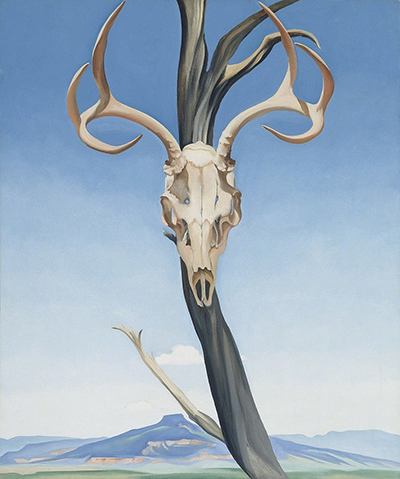Nature would continue to be key to her work, but now it was animal bones that would be seen within her modernist style. As someone who moved home several times, she would frequently discover a wide variety of new sources of inspiration on her doorstep, be it the hectic life of cities, or the desert-like landscape of other parts of the country. It was rare to find such a famous artist deciding to devote a period of their career to animal bones, but that is precisely what happened when O'Keeffe started to spend more and more time at Ghost Ranch, New Mexico. Initially, she worked here part time before falling truly enough with this region. She would go for walks frequently, constantly finding items lying around that could be used in her work.
The deer's skull here is hung from the top of the canvas, giving a similar impression to how the animal may have been looking directly at us before it died. The light is strong upon it, creating shadows even on the narrow antlers. We can feel the warmth and relentless sunshine of this region. In the far distance are the rolling hills of this region, which also appear many times within her work during the 1930s. A large portion of the background is gifted to the sky, even though it is entirely plain in detail. The purpose is to focus our eyes exclusively on the deer's head. It looks menacing, even though the animal is no-longer alive, such is the suggestive angle in which it is hung. The pedernal mentioned in the title of this painting refers to the flat-topped mountain in the background, which she refers to in this quote below.
"...It's my private mountain. It belongs to me. God told me if I painted it enough, I could have it..."
The painting is now owned by the Museum of Fine Arts in Boston, USA. They specialise in European, American and Japanese art within their impressive collection and most of the great names of 19th and 20th century art can be found here. There are, in truth, too many items within their collection to really summarise in just a few highlights, but just to give an example of the notable artworks to be found here, there is The Daughters of Edward Darley Boit and Mrs. Fiske Warren (Gretchen Osgood) and her Daughter Rachel by John Singer Sargent, The Fog Warning by Winslow Homer and also In the Loge by Mary Cassatt. Many items from older movements can also be found here, with the Renaissance and Baroque periods also covered well. Garrowby Hill from David Hockney is amongst the best of their contemporary selection.
